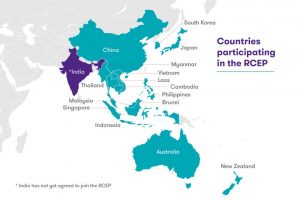Largest Trade Deal In The World Signed By Asian Pacific Nations
Vivian Haas
International Business Writer
The pandemic had taken a toll on many countries around the world, especially in the economic sector of each country. The coronavirus is a world-wide pandemic that resulted in a large financial crisis, affecting nations across the world. Since the pandemic started, many businesses, restaurants, and corporations have been facing financial trouble, causing the global economy to shrink. On October 15th, 2020, the International Monetary Fund (IMF) estimated that the global economy will shrink 4.4% for 2020. As a result, nations all over the world have started taking action against this financial crisis.
As of November 15th, 2020, Asia Pacific nations including China, Japan, and South Korea have officially signed the world’s largest free-trade agreement. This agreement, the Regional Comprehensive Economic Partnership (RCEP), was signed on the sidelines of the annual summit of the Association of Southeast Asian Nations (ASEAN). The RCEP has been discussed for eight years, with negotiations beginning in 2012, and involves fifteen nations in the Asia-Pacific region and ASEAN nations. In terms of GDP, this trade deal is one of the world’s largest trade agreements at USD$26.2 trillion, encompassing over 2.2 billion people and a third of the world’s economy. This pact supports the multilateral trade system and will contribute to lowering tariffs, strengthening supply chains, and codifying new e-commerce rules.

After the pandemic negatively affected the economy, nations see this agreement as a way to strengthen and develop supply chains that have been disrupted by the pandemic. However, not all nations have taken to this new trade deal and have abandoned the agreement before it became official. One nation in particular, India, surprised many participating countries by leaving the agreement last year. The Prime Minister of India, Narendra Modi, expressed concerns over the affects RCEP could have on the livelihoods of Indians, especially those involved in agricultural and manufacturing sectors. Modi was concerned that the elimination of tariffs would result in the harm of local producers who would have to compete with mass imports. Their main concern was China, who could import mass amounts of products, negatively impacting India’s domestic industries. India has suggested a variety of different remedial measures to combat this problem. However, the other countries negotiating over RCEP did not agree to them. As a result, India dropped out of the agreement on November 4th, 2019, but some member nations have expressed that the doors to RCEP will always remain open for India. Despite those who disagree with RCEP, many nations are onboard with the benefits the trade agreement can bring about.
The RCEP will benefit many of the nations involved in this trade deal. Australian farmers and businesses will receive better export opportunities and gain greater investment certainties and Australia hopes that this trade agreement will strengthen ties with China, one of its biggest trading partner. Australia is especially excited about the increased strength of supply chains and is working to rebuild its economy from the pandemic. In addition, this free-trade agreement will help Indonesia to increase its GDP by 0.05 percent from 2021 to 2023. These countries, and more, are looking forward to the progress and innovation this deal can bring to ASEAN and the Asia-Pacific nations. This agreement will result in making exports of participating countries more competitive and create an integrated market for all involved nations.
Contact Vivian at haasvivi@shu.edu

